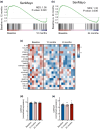Calorie restriction reduces biomarkers of cellular senescence in humans
- PMID: 37961856
- PMCID: PMC10861196
- DOI: 10.1111/acel.14038
Calorie restriction reduces biomarkers of cellular senescence in humans
Abstract
Calorie restriction (CR) with adequate nutrient intake is a potential geroprotective intervention. To advance this concept in humans, we tested the hypothesis that moderate CR in healthy young-to-middle-aged individuals would reduce circulating biomarkers of cellular senescence, a fundamental mechanism of aging and aging-related conditions. Using plasma specimens from the Comprehensive Assessment of Long-term Effects of Reducing Intake of Energy (CALERIE™) phase 2 study, we found that CR significantly reduced the concentrations of several senescence biomarkers at 12 and 24 months compared to an ad libitum diet. Using machine learning, changes in biomarker concentrations emerged as important predictors of the change in HOMA-IR and insulin sensitivity index at 12 and 24 months, and the change in resting metabolic rate residual at 12 months. Finally, using adipose tissue RNA-sequencing data from a subset of participants, we observed a significant reduction in a senescence-focused gene set in response to CR at both 12 and 24 months compared to baseline. Our results advance the understanding of the effects of CR in humans and further support a link between cellular senescence and metabolic health.
Keywords: CALERIE™; aging; biomarkers; caloric restriction; inflammation; metabolism; senescence-associated secretory phenotype.
© 2023 The Authors. Aging Cell published by Anatomical Society and John Wiley & Sons Ltd.
Conflict of interest statement
NKL and Mayo Clinic have intellectual property related to this work licensed to a commercial entity. This research has been reviewed by the Mayo Clinic Conflict of Interest Review Board and is being conducted in compliance with Mayo Clinic Conflict of Interest policies.
Figures



References
-
- Acosta, J. C. , Banito, A. , Wuestefeld, T. , Georgilis, A. , Janich, P. , Morton, J. P. , Athineos, D. , Kang, T. W. , Lasitschka, F. , Andrulis, M. , Pascual, G. , Morris, K. J. , Khan, S. , Jin, H. , Dharmalingam, G. , Snijders, A. P. , Carroll, T. , Capper, D. , Pritchard, C. , … Gil, J. (2013). A complex secretory program orchestrated by the inflammasome controls paracrine senescence. Nature Cell Biology, 15(8), 978–990. 10.1038/ncb2784 - DOI - PMC - PubMed
-
- Armamento‐Villareal, R. , Sadler, C. , Napoli, N. , Shah, K. , Chode, S. , Sinacore, D. R. , Qualls, C. , & Villareal, D. T. (2012). Weight loss in obese older adults increases serum sclerostin and impairs hip geometry but both are prevented by exercise training. Journal of Bone and Mineral Research, 27(5), 1215–1221. 10.1002/jbmr.1560 - DOI - PMC - PubMed
-
- Aversa, Z. , Atkinson, E. J. , Carmona, E. M. , White, T. A. , Heeren, A. A. , Jachim, S. K. , Zhang, X. , Cummings, S. R. , Chiarella, S. E. , Limper, A. H. , & LeBrasseur, N. K. (2023). Biomarkers of cellular senescence in idiopathic pulmonary fibrosis. Respiratory Research, 24(1), 101. 10.1186/s12931-023-02403-8 - DOI - PMC - PubMed
-
- Basisty, N. , Kale, A. , Jeon, O. H. , Kuehnemann, C. , Payne, T. , Rao, C. , Holtz, A. , Shah, S. , Sharma, V. , Ferrucci, L. , Campisi, J. , & Schilling, B. (2020). A proteomic atlas of senescence‐associated secretomes for aging biomarker development. PLoS Biology, 18(1), e3000599. 10.1371/journal.pbio.3000599 - DOI - PMC - PubMed
Publication types
MeSH terms
Substances
Grants and funding
- R33 AG070455/AG/NIA NIH HHS/United States
- U01 AG020487/AG/NIA NIH HHS/United States
- U01 AG020478/AG/NIA NIH HHS/United States
- U01 AG022132/AG/NIA NIH HHS/United States
- U01AG022132/AG/NIA NIH HHS/United States
- P30 DK056341/DK/NIDDK NIH HHS/United States
- U54 GM104940/GM/NIGMS NIH HHS/United States
- U01AG020487/AG/NIA NIH HHS/United States
- P01 AG062413/AG/NIA NIH HHS/United States
- R01 AG055529/AG/NIA NIH HHS/United States
- R01AG071717/AG/NIA NIH HHS/United States
- U01AG020480/AG/NIA NIH HHS/United States
- R56 AG060907/AG/NIA NIH HHS/United States
- U01AG020478/AG/NIA NIH HHS/United States
- U01 AG020480/AG/NIA NIH HHS/United States
- P30 AG031679/AG/NIA NIH HHS/United States
- R01 AG076515/AG/NIA NIH HHS/United States
- P30 DK072476/DK/NIDDK NIH HHS/United States
- R01 AG071717/AG/NIA NIH HHS/United States
- R33AG070455/AG/NIA NIH HHS/United States

